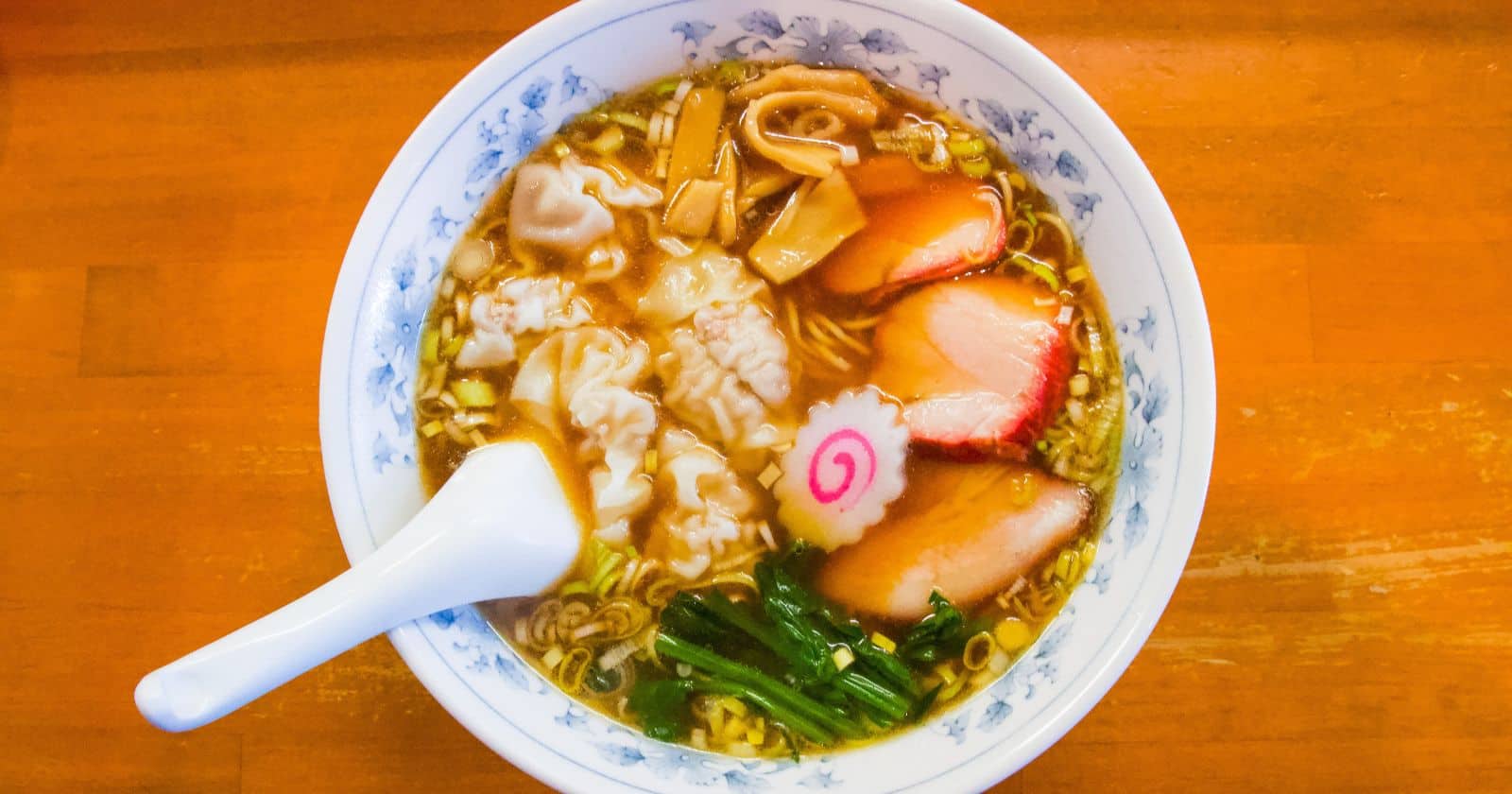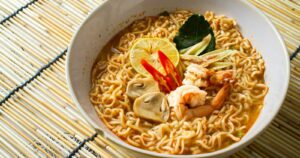Ramen is practically synonymous with comfort food. With its savory broth, chewy noodles, and endless topping options, it’s no wonder ramen restaurants are so popular. But is that giant bowl of noodles actually good for you when dining out?
The short answer is – not usually. Traditional restaurant ramen tends to be high in calories, sodium, and refined carbs. But by making smart choices like picking vegetable broth, loading up on veggies, and avoiding fatty meats, you can enjoy ramen without ditching your healthy diet.
Here’s a closer look at why restaurant ramen has a reputation for being unhealthy, along with easy tips to make your ramen orders more nutritious. Get ready to slurp down those noodles guilt-free!
Understanding the High Calories and Sodium in Restaurant Ramen
A steaming bowl of ramen may seem innocuous, but traditional restaurant ramen often contains surprisingly high amounts of calories, sodium, and refined carbs.
The Shocking Calorie Count
- A large restaurant ramen bowl can contain around 954 calories, almost half the recommended daily calorie intake for an average adult.
- The high calorie count comes from the fatty broth, abundant noodles, and fatty pork belly or cha shu toppings.
- Eating high calorie restaurant ramen frequently can contribute to weight gain over time.
Sky-High Sodium Content
- Restaurant ramen can contain up to 2691mg sodium per 3 cup serving, exceeding the recommended 2400mg daily sodium intake.
- The intensely flavored broth is the main source of sodium, from salt, soy sauce, miso paste or msg.
- High sodium intake is linked to high blood pressure, heart disease, stroke, and other health issues.
Refined Carbs Galore
- Ramen noodles are made from refined wheat flour, giving 75-100g carbohydrates per serving.
- Refined carbs digest quickly and cause unstable blood sugar levels. They provide calories but lack fiber, vitamins or minerals.
- Overdoing refined carbs can increase risks of diabetes, weight gain, and metabolic syndrome.
Clearly, traditional restaurant ramen is more of an occasional indulgence food rather than a regular part of a healthy diet. But with a few adjustments, it is possible to enjoy ramen more often without overloading on calories, sodium or carbs.
Healthier Ramen Options at Restaurants
Luckily, many ramen restaurants now offer healthier ramen options. With the right choices, you can still satisfy your ramen craving without ditching your diet goals.
Opt for Broth Made with Chicken or Vegetable Stock
Broth made from pork bones adds rich flavor but also piles on the calories and saturated fat. Chicken or vegetable stock makes a lighter, healthier base for the broth.
Load Up On the Veggies
Pack your ramen with extra vegetables like spinach, bean sprouts, cabbage, carrots, mushrooms, and bamboo shoots. This boosts fiber, vitamins and antioxidants.
Choose Fresh or Whole Grain Noodles
Fresh ramen noodles have fewer additives than instant noodles. Whole grain noodles add more fiber and nutrients than refined white flour noodles.
Add Lean Proteins
Lean proteins like grilled chicken, shrimp or tofu make the ramen more satisfying. Avoid fatty meats like pork belly.
Request Low Sodium Broth
Ask if your ramen restaurant can prepare your broth with reduced sodium. This small change can cut hundreds of milligrams of sodium.
Watch Portion Sizes
Stick to smaller ramen bowl sizes or share a regular portion to control calorie intake. Resist the urge to polish off a huge restaurant-sized bowl by yourself.
Healthy Ramen Topping Ideas
Ramen toppings provide lots of opportunities to add nutrition to your bowl. Load up on healthy add-ins:
- Soft boiled eggs – High in protein, low in calories
- Edamame – Fiber, plant protein
- Bok choy – Vitamin C, calcium
- Seaweed – Iodine, fiber, vitamins
- Kimchi – Probiotics, fiber, vitamins
- Bean sprouts – Low calorie vegetable
- Shiitake mushrooms – B vitamins, selenium
- Tofu – Plant protein, calcium
On the other hand, limit fatty, sugary toppings like:
- Fatty pork belly
- Mayonnaise-based sauces
- Fried items like tempura
- Sugary drinks
Healthier Ramen Noodle Alternatives
Traditional white flour ramen noodles are fairly unhealthy. But alternative noodle options let you enjoy ramen with more nutrients:
Whole Wheat Ramen Noodles
- More fiber, B vitamins, minerals
- Contains wheat bran and germ
- Richer flavor from whole grains
Buckwheat Soba Noodles
- Higher protein than white noodles
- Gluten-free
- Nutty, earthy flavor
Shirataki Noodles
- Made from konjac yam, almost zero carbs/calories
- Gelatinous texture
- Good for low-carb diets
Zucchini Noodles
- Low calorie vegetable noodles
- Naturally gluten-free
- Fresh flavor and crunch
Spaghetti Squash
- Low calorie substitute for pasta
- Rich in vitamin A, potassium
- Naturally sweet flavor
So with a bowl of whole grain noodles, a veggie-packed broth, and lean protein toppings, you can craft a ramen bowl that is nutritious and satisfying, not just delicious.
Healthy Side Dishes to Accompany Your Ramen
To make your restaurant ramen meal even more balanced, order some healthy vegetable side dishes:
Roasted Brussels Sprouts
Get a boost of fiber, vitamin C, vitamin K, and antioxidants from brussels sprouts roasted until crispy. The high heat caramelizes their natural sugars for sweetness.
Miso Glazed Eggplant
Eggplant is low in calories and high in fiber. Miso glaze adds a delicious umami savory flavor and antimicrobial compounds.
Spicy Korean Cucumber Salad
Cucumbers are hydrating and pair well with the saltiness of ramen. Spicy Korean chili sauce or gochujang paste gives a kick of capsaicin, linked to anti-inflammatory benefits.
Vegetable Tempura
Get crispy vegetables like broccoli, squash, sweet potatoes, coated in a light tempura batter and quickly fried. While deep frying isn’t very healthy, the vegetables increase vitamins, minerals and fiber.
Green Tea Ice Cream
This Japanese favorite provides the antioxidants of matcha green tea powder. It has a lower sugar and fat content than most ice cream.
Healthy Homemade Ramen
While dining out, look for ramen restaurants with healthier options. But for full control over nutrition and ingredients, making ramen at home is ideal. Follow these tips:
- Use chicken or vegetable broth instead of pork-based broth
- Choose whole grain or alternative noodles
- Load up with veggies like spinach, carrots, mushrooms, cabbage
- Add lean proteins like shrimp, chicken or tofu
- Use less sodium and MSG in broth seasoning
- Control portion sizes
- Make extras for leftovers
With the right ingredients and techniques, you can create a homemade ramen bowl that is truly healthy and still packed with flavor. Slurping noodles has never been so guilt-free!
The Bottom Line on Healthy Ramen
Traditional restaurant ramen is high in sodium, refined carbs, and calories. But by choosing broth with vegetable or chicken stock, increasing vegetables, using whole grain or alternative noodles, and adding lean protein, ramen can be a more balanced meal. Controlling portions and sodium content also helps decrease the health impact.
While not an everyday food, healthier ramen options can be worked into an overall nutritious diet. With a few adjustments to ingredients and cooking techniques, you can still enjoy this comforting dish while supporting your health goals.





